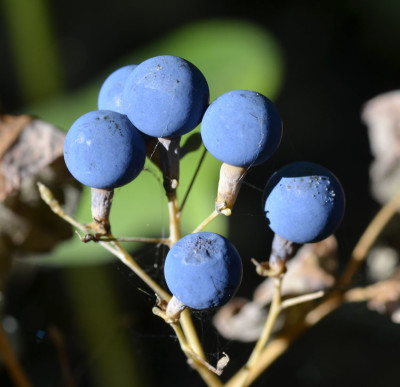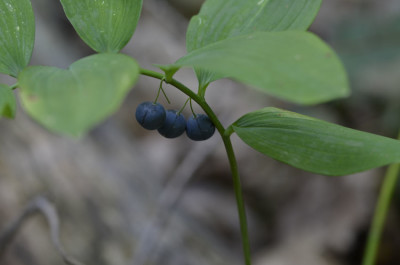I’d better start by stating that I call any small fruit a berry regardless of whether it is actually a drupe, berry, accessory fruit, aggregate fruit, multiple fruit, pome, pepo or hesperidium. If you didn’t know there were that many ways to label fruits you’re not alone: neither did I until I read an article on how these categories are used.
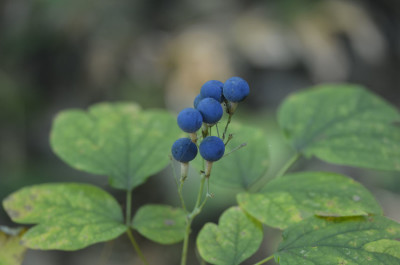
These were the only Blue Cohosh berries I found with still-green leaves.
Anyway, I thought I’d try to group some descriptions and photos of blue fruit that I’ve seen on September walks in case anyone else is trying to check what they were looking at.
WARNING: Don’t Eat Wild Fruits
Please don’t eat any of these fruits! I have no idea which ones are edible and if they are not poisonous then the wild animals still need them more than we do.
What Are These Cranberry-sized Blue Berries on a Tall Dead Stalk in the Forest?
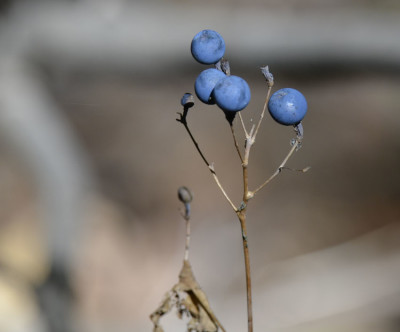
Most of the Blue Cohosh berries I found were on dry twigs with dead leaves.
I went looking for these fruit because I’d first seen the plants in bloom in the very early spring. Now, in September, the Blue Cohosh plants I saw no longer had any leaves left. Tall, pale stalks held up small groups of big fruit.
What Plant Has a Row of Large Individual Blue Berries Hanging Down Along a Stem of Leaves?

Pairs of Solomon’s Seal berries.
Solomon’s Seal plants have a distinctive leaf pattern. A long stem, which can be 30 cm (2 feet) or more in length, has clasping slender pointed leaves perpendicular to the length. In fall, the fruit hang down on short stems, under each leaf stem, usually in pairs.
I hadn’t seen the ripe berries on Solomon’s Seal before this fall, either. So I was pleased to find it in two different locations to take a photo. (Given the darkness of the forests, my photos are not particularly good. I need to learn more about low-light-level photography.)
Belatedly, I have discovered there are two types of Solomon’s Seal, Smooth and Hairy, that could grow in these areas. Next time I see them, I’ll have to check the leaves more closely.
Another plant with similar leaves, called False Solomon’s Seal, has all of the berries at the end of the long stem in a cluster of golden then red fruit.
What Are These Blue Berries on Red Stems on a Bush?
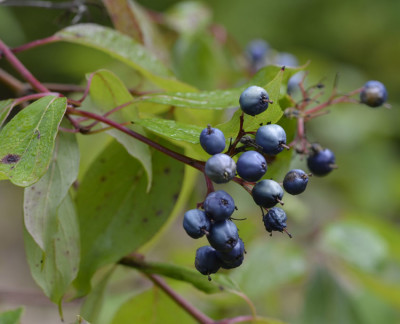
I believe these are some type of Dogwood fruit.
Starting in the late summer and continuing into September, I started noticing these bright blue fruit on shrubs in many locations. Some were in forested areas. Others were in the open, including one growing practically out of the limestone in a former quarry.
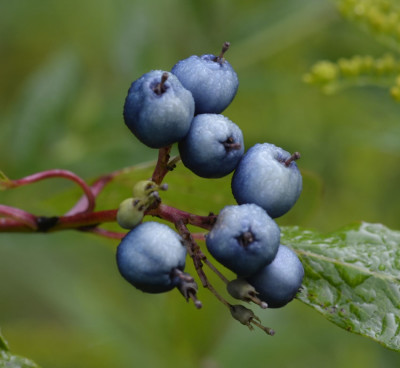
They look quite attractive with the red stems. (There was regular Red Osier Dogwood with its white fruit nearby.)
I don’t actually know what kind of shrubs these are. They appear to be a Dogwood. It might be Silky Dogwood which is listed as seen in the Rattray in a Credit Valley Conservation document. There are many different types of native dogwoods, though, and then there are the escaped cultivated versions. I’ll keep puzzling away at it but for now I’m just guessing.
Are These Wild Grapes?
If the vine you are looking at has the same large leaves as these, chances are good you’re asking about Riverbank Grapes. They are more common in sunshine than in deep forest but I have seen the vines in forested areas, so they are included in this list. Be careful, though, to check exactly which vine the grapes are on, however, as another vine may be entwined with them.
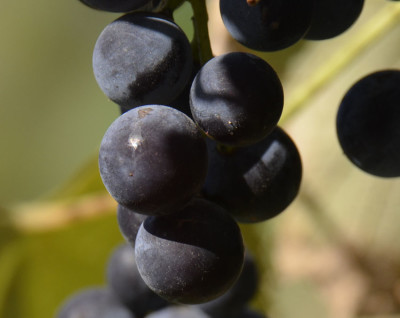
These grapes were almost the size of edible Concord grapes, but I have seen others which are much smaller.
What About These Smaller Blue or Purple Berries Also on a Vine?
These next ones are not grapes. They are the fruit of the Virginia Creeper or Parthenocissus quinquefolia vine. The leaves are quite different from Riverbank Grape but the two plants often grow together or over top of one another. In addition to the wild native variety, there are many ornamental varieties of Virginia Creeper that have escaped into the wild.
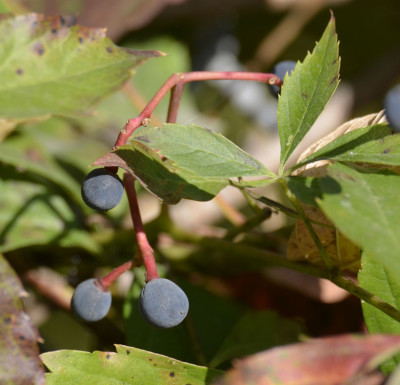
Virginia Creeper leaves often have 5 parts.
According to a USDA website, the berries are very toxic to humans. plants. As mentioned earlier, don’t eat any of these and you’ll stay safe.
Personally, I find it rewarding enough to watch the Catbirds, Robins and other creatures eating from these vines.
What’s This Unusual Large Tight Lump of Blue Berries on a Vine?
UPDATE 2018 10 06: Some type of Carrion Vine berries in Mississauga, seen on 2014 10 06.
These are Carrion Vine berries. I haven’t seen them in the Greater Toronto Area, although they may be here, but I have seen them in south-eastern Ontario.
OK, so I can’t find my photo: I promise to update this when I find it! [Done! I didn’t find the photo I expected but I found a different one.]
Related Reading
- Not So Deadly Nightshade Berries
- Yes, These Are Jack In the Pulpit Seeds Not Some Odd Red Fungus Fruiting
- Blue Cohosh Baffles With Purple Grey Stems
Join In
Do you have another blue fruit of the forest to add to this list? Please share your favourite with a comment.

